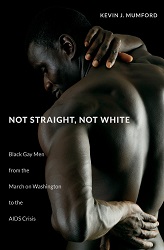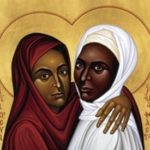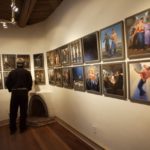Last Updated on June 11, 2024 by Kittredge Cherry

James S. Tinney was a black gay professor who founded an African American LGBTQ church in Washington DC in 1982. He died at age 46 on June 12, 1988, from complications due to AIDS.
Born in Kansas City, he was ordained as a Pentecostal minister when he was 18 and pastored several churches in Arkansas and Missouri. He also worked as a journalist at various publications. His legacy lives on in his many writings about the valuable role of black LGBTQ people in the church, especially the Pentecostal tradition.
He supported and broke the silence about LGBTQ people in the church with public speaking and writing such as in his 1977 article “Homosexuality as a Pentecostal Phenomenon,” which appears in the 2013 book “Black Fire Reader: A Documentary Resource on African American Pentecostalism.”
 “Few things excite so much interest as the topic of sex; and yet on fewer issues has the church been more silent…. Ministers and bishops consistently avoid admitting that many professed (and otherwise exemplary) Christians are not only homosexuals by inclination, but also by practice, whether frequently or infrequently,” he wrote.
“Few things excite so much interest as the topic of sex; and yet on fewer issues has the church been more silent…. Ministers and bishops consistently avoid admitting that many professed (and otherwise exemplary) Christians are not only homosexuals by inclination, but also by practice, whether frequently or infrequently,” he wrote.
A full chapter is devoted to Tinney in the 2019 book “Not Straight, Not White. Black Gay Men from the March on Washington to the AIDS Crises” by Kevin Mumford. The book describes Faith Temple as “the first black gay and lesbian church.”
Faith Temple was apparently founded in 1982, the same year that Carl Bean founded Unity Fellowship, a black LGBTQ church in Los Angeles.
Mainstream Pentecostal leaders attacked Tinney’s LGBTQ church activities in a variety of ways, which he described in a speech to the predominantly LGBTQ Metropolitan Community Churches at their General Conference in Houston, Texas on Aug. 5, 1981. He also affirmed his conviction as a black gay Christian to remain true to himself and his God:
“Ask me not if my suffering causes me to long for some other orientation, some different direction of affection – as if I would become heterosexual if I could. My answer is this: Never would I choose to be other than I am. If I were to exchange who I am and what I am for some other, it would be no longer I who lived, but them. My being is God’s gift of creation; to deny myself would be to deny God’s own self.”
The text of the entire speech is online at the Religious Institute. Speaking about a year before he founded Faith Temple, he described MCC as a church “which I love although I am not officially a member of it.”
James Tinney did LGBTQ ministry despite rejection
Tinney came out to his wife, Darlene, in 1969 and was rejected by her and his church. He moved to Washington in 1973, earning a PhD at Howard University. In 1976 he joined the faculty at Howard University as a journalism professor, a position he held for the rest of his life. His bio at the LGBTQ Religious Archives says that later he “lived quietly with two successive lovers who were also active Pentecostals.”
In the 1970s he also worked as a speechwriter for Congressman John Conyers Jr. (D-Mich.) and Samuel C. Jackson, who was an undersecretary of the Department of Housing and Urban Development during the Nixon administration.
Tinney came out publicly in 1979 in a speech at the first gathering of the Third World Lesbian and Gay Conference. The following year he founded the Pentecostal Coalition for Human Rights in an effort to help LGBTQ people reconcile their faith and sexuality.
He delivered a landmark sermon titled “ ‘What Doth Hinder Me?’ The Conversion of a Black Homosexual as Recorded by St. Luke” at Metropolitan Church of Philadelphia, Nov. 15, 1981. In the sermon, he provided a gay-friendly interpretation of the Ethiopian eunuch who was baptized by Philip. Tinney claimed that “eunuchs in the Ancient Near Eastern world were at least disposed toward homosexuality, if not practicing homosexuals.” The sermon is included in the 1985 book “Good News for Modern Gays: A Pro-Gay Biblical Approach” by Sylvia Pennington.
His activism grew when he organized a three-day citywide gay and lesbian revival in 1982. As a result, he was excommunicated from the church where he served as lay minister: Temple Church of God in Christ.
This led him to found Faith Temple Christian Church, a nondenominational church with a largely black gay and lesbian congregation. The church met at New York Avenue Presbyterian Church in Washington. Tinney organized several conferences through Faith Temple to build bridges between fundamentalist churches and the LGBTQ community.
Tinny discusses why he founded Faith Temple in the book “Unrepentant, Self-Affirming, Practicing: Lesbian/Bisexual/Gay People Within Organized Religion” by Gary David Comstock. LGBTQ black gays couldn’t be open in black churches, but they didn’t feel comfortable in the Washington area’s largely white LGBTQ churches, he said in an interview in the book. Tinney did not accuse the white churches of racism, but said that many black congregants wanted a culturally familiar church experience that was similar to the Baptist and Pentecostal churches of their childhoods.
Tinney also founded an annual Black Religious Writers’ Workshop, the Society of Blacks in Religious Communications and the first scholarly journal about Black Pentecostalism, “Spirit: A Journal of Issues Incident in Black Pentecostalism.”
Tinney’s legacy continues
Although Tinney gets little attention in the LGBTQ community today, his legacy lives on in work by and about him.
Tinney has a halo with the rainbow colors of the LGBTQ community in a 2021 portrait by North Carolina artist Jeremy S. Whitner. It appears at the top of this post. The image presents Tinney in monochromatic purple, a color long associated with queer people. Whitner manages to find the right balance between styles: He paints Tinney with the respectful tone of a face on a coin or dollar bill — and also with a flamboyant 1980s aesthetic similar to the colorful celebrity portraits by Andy Warhol.
While others wrote about him, Tinney himself wrote many books and articles, often arguing that the origins of Pentecostalism were uniquely African American. His books include the 1987 volume “America’s First Black Gay Christian Activist” about Grant-Michael Fitzgerald (1947 – 1986), an African American Catholic brother who advocated for LGBTQ rights in the Catholic church.
After his death from AIDS-related complications, Tinney was buried at Mount Washington Cemetery in Independence, Missouri, with a headstone that featuring a quill pen and graduation cap to highlight his courageous scholarship.
___
Top image credit:
James S. Tinney icon by Jeremy S. Whitner
___
Related links:
James Tinney at LGBT Religious Archives
James Tinney, Howard U. Professor, Dies (Washington Post)
___
This post is part of the LGBTQ Saints series by Kittredge Cherry. Traditional and alternative saints, people in the Bible, LGBT and queer martyrs, authors, theologians, religious leaders, artists, deities and other figures of special interest to lesbian, gay, bisexual and transgender and queer (LGBTQ) people and our allies are covered.
This article was originally published on Q Spirit on June 17, 2021, expanded with new material over time, and was most recently updated on June 12, 2023.
Copyright © Kittredge Cherry. All rights reserved.
Qspirit.net presents the Jesus in Love Blog on LGBTQ spirituality.




















